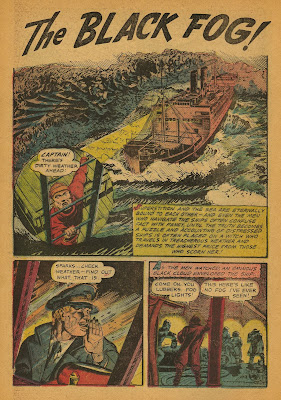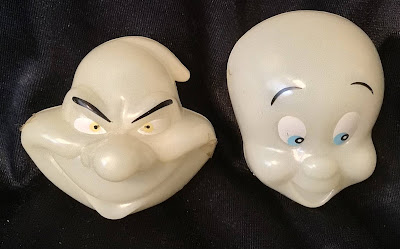 |
| An illustration from Varney the Vampyre |
(From the Leeds Mercury, dated Thursday 18th May 1871)
Vampyres And Ghouls
These gentry are not yet quite dead. At least the belief in them still lingers in some country districts ; while in South-Eastern Europe and South-Western Asia, the credence prevails among whole tribes, and even nations. There appears to be no essential difference between the European vampyre and the Asiatic ghoul - a sort of demon, delighting to animate the bodies of dead persons, and feed upon their blood. It is believed that the superstition has existed in the Levant since the time of the ancient Greeks ; but among that artistic people the vampyre was a Lamia, a beautiful woman, who allured youths to her, and then fed upon their young flesh and blood. Be that as it may, the Byzantine Christians, after the time of Constantine, entertained a belief that the bodies of those who died excommunicated were kept by an emissary of the Evil One, who endowed them with a sort of life, sufficient to enable them to go forth at night from their graves, and feast on other men. the only way to get rid of these passive agents of mischief was to dig the bodies up from their graves, dis-excommunicate them, and bury them.
The most detailed vampyre stories belong to the Danubian and Greek countries. Tournefort describes a scene that came under his personal notice in Greece. A peasant of Mycone was murdered in the fields in the year 1701. He had been a man of quarrelsome, ill-natured disposition ; just the sort of man, according to the current belief of the peasantry, to be haunted by vampyres after death. Two days after his burial, it was noised abroad that he had been seen to walk in the night with great haste, overturning people's goods, putting out their lights, pinching them, and playing strange pranks. The rumour was so often repeated, that at length the priests avowed their belief in its truth. Masses were said in the chapels, and ceremonies were performed, having for their object to drive out the vampyre that inhabited the dead man. On the tenth day after the burial, a mass was said, the body was disinterred, and the heart taken out. Frankincense was burned to ward off infection ; but the bystanders insisted on the smoke of the frankincense being a direct emanation from the body - a sure sign, according to popular belief, of vampyrism. They burned the heart on the sea-shore, the conventional way of getting rid of vampyres. Still this did not settle the matter. Positive statements went the round of the village that the dead man was still up to all kinds of mischief, beating people in the night, breaking down doors, unroofing houses, shaking windows. The matter became serious. Many of the inhabitants were so thoroughly frightened and panic-striken as to flee ; while those who remained nearly lost all self-control. They debated, they fasted, they made processions through the village, they sprinkled the doors of the homes with holy water, they speculated as to whether mass had been properly said, and the heart properly burned. At length they resolved to burn the body itself ; they collected plenty of wood, pitch, and tar, and carried out their plan. Tournefort (who had found it necesary to be cautious as to expressing his incredulity) states that no more was heard of the supposed vampyre.
In the year 1725, on the borders of Hungary and Transylvania, a vampyre story arose, which was renewed afterwards in a noteworthy way. A peasant of Madveiga, named Arnold Paul, was crushed to death by the fall of a waggon-load of hay. Thirty days afterwards four persons died, with all the symptoms (according to popular belief) of their blood having been sucked by vampyres. Some of the neighbours remembered having heard Arnold say that he had often been tormented by a vampyre ; and they jumped to a conclusion that the passive vampyre had now become active. This was in accordance with a kind of formula or theorum on the subject : that a man who, when alive, had had his blood sucked by a vampyre, will, after his death, deal with other persons in like manner. the neighbours exhumed Arnold Paul, drove a stake through the heart, cut off the head, and burned the body. The bodies of the four persons who recently died were treated in a similar way, to make surety doubly sure. Nevertheless, even this did not suffice. In 1782, seven years after these events, seventeen persons died in the village near about one time. The memory of the unlucky Arnold recurred to the villagers ; the vampyre theory was again appealed to ; he was believed to have dealt with the seventeen as he had previously dealt with the four ; and they were therefore disinterred, the heads cut off, the hearts staked, the bodies burned, and the ashes dispersed. One supposition was that Arnold had vampyrised some cattle, that the seventeen villagers had eaten of the beef, and had fallen victims in consequence. This affair attracted much attention at the time. Louis the Fifteenth directed his ambassador at Vienna to make inquiries in the matter. Many of the witnesses attested on oath that the disinterred bodies were full of blood, and exhibited few of the usual symptoms of death : indications which the believers in vampyres stoutly maintained to be always present in such cases. This has induced many physicians to think that real case of catalepsy or trance were mixed up with the popular belief, and were supplemented by a large allowance of epidemic fanaticism.
 |
| A Possible Illustration Of Mr. Pashley, from his book 'Travels in Crete' |
Mr. Pahley, in his Travels in Crete, states that when he was at the town of Askylo, he asked about the vampyres or katakhanadhes, as the Cretans called them, of whose existence and doings he had heard many recitals, strongly corroborated by the peasantry. Many of the stories converged toward one central fact, which Mr. Pashley believed had given origin to them all. On one occasion a man of some note was buried at St. George's Church at Kalikrati, in the island of Crete. An arch or canopy was built over his grave. But he soon afterwards made his appearance as a vampyre, haunting the village, and destroying men and children. A shephered was one day tending to his sheep and goats near the church, and on being caught in a shower, he went under the arch to seek shelter from the rain. He determined to pass the night there, laid aside his arms, and stretched himself on a stone to sleep. In placing his fire-arms down (gentle shepherds of pastoral poems do not want fire-arms ; but the Cretans are not gentle shepherds), he happened to cross them. Now this crossing was always believed to have the effect of preventing a vampyre from emerging from the spot where the emblem was found. Thereupon occurred a singular debate. The vampyre rose in the night, and requested the shepherd to remove the firearms in order that he might pass, as he had some important business to transact. The shepherd inferring from this request that the corpse was the identical vampyre which had been doing so much mischief, at first refused his assent ; but on obtaining from the vampyre a promise on oath that he would not hurt him, the shepherd moved the crossed arms. The vampyre, thus enabled to rise, went to a distance of about two miles, and killed two persons, a man and a woman. On his return, the shepherd saw some indication of what had occurred, which caused the vampyre to threaten him with a similar fate if he divulged what he had seen. He courageously told all, however. The priests and other persons came to the spot next morning, took up the corpse (which in daytime was as lifeless as any other) and burnt it. While burning, a little spot of blood spurted on the shepherd's foot, which instantly withered away ; but otherwise no evil resulted, and the vampyre was effectually destroyed. This was certainly a very peculiar vampyre story ; for the coolness with which the corpse and the shepherd carried on their conversation under the arch was unique enough. Nevertheless, the persons who narrated the affair to Mr. Pashley firmly believed in its truth, although slightly differing in their versions of it.
Modern vampyres in Western europe seldom trouble society, so far as narratives tell ; but across the Atlantic something of the kind has occupied public attention within the limits of the present generation. In 1854, the Times gave an extract from an American newspaper, the Norwich Courier, concerning an event that had just occurred. Horace Ray, of Griswald, died of consumption in 1846 ; two of his children afterwards died of the same complaint ; eight years afterwards, in 1854, a third died. The neighbours, evidently having the vampyre theory in their thoughts, determined to exhume th ebodies of the first two children, and burn them ; under the suposition that the dead had been feeding on the living. If the dead body remained in a fresh or semi-fresh state, all the vampyre mischief would be produced. In what state the bodies were really found we are not told ; but they were disinterred and burned on the 5th of June in the above-named year.
This superstition appears to be closely connected with that of the Were-wolf, which sometimes presents very terrible features. Medical men give the name lycanthropy to a kind of monomania which lies at the bottom of all the were-wolf stories. In popular interpretation. a were-wolf is a man or woman who has been changed into the form of a wolf, either to gratify a taste for human flesh and blood, or as a Divine punishment. The Rev. Baring Gould narrates the history of Marshal de Retz, a noble, brave, and wealthy man of the time of Charles the Seventh in France. He was sane and reasonable in all matters save one ; but in that one he was a terrible being. He delighted in putting young and delicate children to death, and then destroying them, without (so far as it appears) wishing to put the flesh or blood to his lips. In the course of a lengthened trial which brought his career to an end, the truth came to light that he had destroyed eight hundred children in seven years. there was neither accusation nor confession about a wolf here ; it was a man afflicted with a morbid propensity of a dreadful kind. Somewhat different was the case of Jean Grenier, in 1603. He was a herd boy, aged fourteen, who was brought before a tribunal at Bordeaux on a most extraordinary charge. Several witnesses, chiefly young girls, accused him of attacking them under the guise of a wolf. The charge was strange, but the confession was still stranger ; for the boy declared that he had killed and eaten several children, and the fathers of those children asserted the same thing. Grenier was said to be half an idiot ; if so, his idiocy on the one hand, and the superstitious ignorancy of the peasantry on the other, may perchance supply a solution to the enigma.
 |
| Père Lachaise Cemetery, France |
One of the most extraordinary cases on record occurred in France in 1849, the facts being brought to light before a court-martial, presided over by Colonel Manselon. Many of the cemetries near Paris were found to have been entered in the night, graves opened, coffins disturbed, and dead bodies strewed around the place in a torn and mangled condition. This was so often repeated, and in so many cemeteries, that great anguish and terror were spread among the people. A strict watch was kept. Some of the patrols or police of the cemeteries thought they saw a figure several times flitting about among the graves, but could never quite satisfy themselves on the matter. Surgeons were examined to ascertain whether it was the work of the class of men who used to be in England called resurrectionists, or body-snatchers ; but they all declared that the wild reckless mutilation was quite of another character. Again was a strict watch kept ; a kind of man-trap was contrived at a part of the all of Père la Chaise cemetery which appeared as if it had been recently scaled. A sort of grenade connected with the man-trap was heard to explode; the watch fired their guns ; some one was was seen to flee quickly ; and then they found traces of blood, and a few fragments of military clothing, at one particular spot. Next day, it became publicly known that a non-commissioned officer of the Seventy-fourth Regiment had returned wounded to the barracks in the middle of the night, and had been conveyed to miltary hospital. Further inquiry led to a revelation of the fact that Sergt. Bertrand, of the regiment here named, was the unhappy cause of all the turmoil. He was in general demeanour kind and gentle, frank and gay ; and nothing but a malady of a special kind could have driven him to the commission of such crimes as those which he was charged, and which his own confession helped to confirm. He described the impulse under which he acted as being irresistible, altogether beyond his own control ; it came upon him about once a fortnight. He had a terrible conciousness while under its influence, and yet he could not resist. The minute details which he gave to the tribunal of his mode of proceeding at the cemeteries might suit those who love to sup on horrors, but may be dispensed with here. Suffice it to say that he aided by his confession to corroborate the charge ; that he was sentenced to twelve months imprisonment ; and that eminent physicians of Paris endeavoured to restore the balance of his mind during his quiet incarceration. - All The Year Round.
-------------------------------
Blimey, only one day left! That came around quick! The Countdown is nearly over, but there's still plenty of time to check out what all the other bloggers taking part have been up to by clicking the badge below and visiting the Countdown to Halloween hub! I'll be back tomorrow, possibly with more than one post if time allows!





















































